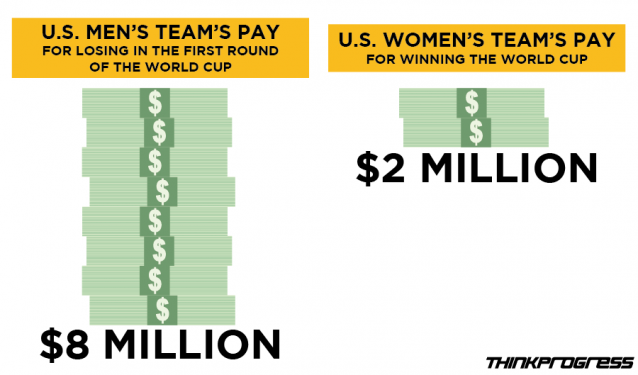 The U.S. women’s soccer team is already on a roll at the Olympics in Rio.
The U.S. women’s soccer team is already on a roll at the Olympics in Rio.
So far, they haven’t lost a single game they’ve played, winning against New Zealand and France and tying with Colombia. They didn’t even give up a goal during the first two games and are now first in their group. They’re well on their way toward gold.
Yet the victorious streak comes amid their continuing fight to be paid equally with the U.S. men’s team, which didn’t even qualify to participate in this year’s summer Olympics.
In March, five stars on the U.S. Women’s National Team (USWNT)?—?Carli Lloyd, Becky Sauerbrunn, Alex Morgan, Megan Rapinoe, and Hope Solo?—?filed a complaint on behalf of everyone on the women’s team with the Equal Employment Opportunity Commission (EEOC). They alleged that the U.S. Soccer Federation unfairly pays female players less than those on the men’s team.
In their complaint, the players claimed that they are paid almost four times less than the men’s team players. For example, the women say they are paidjust $1,350 each for winning a friendly match and nothing for a tie or loss, compared to $9,375 for a men’s victory (even more if they win against a top-ranked team), $6,250 for a tie, and $5,000 for a loss.
The women’s team has a contract specifying that top-tier players get $72,000 a year as a base salary, while the men aren’t guaranteed payment. But the complaint pointed out that if the USWNT were to lose all 20 friendlies in a season, a player would get $72,000, while if it won all 20 she would get $99,000. The men, on the other hand, get $100,000 a year for losing all 20 friendlies, $1,000 more than a victorious female player. Meanwhile, they get about $263,000 each for winning all 20 matches–38 percent more than a winning women’s player.
The women’s team also gets nothing for playing in World Cup matches until they get into fourth place, even though the men’s team gets payment for each game played regardless of the result. They got just $2 million for winning the World Cup last year, while the U.S. men’s team earned $8 million for losing in the first round. Meanwhile, the German team that won the men’s World Cup got $35 million.

The women have argued that their pay is unfair in part because the men are compensated more for just showing up, while the women have to perform at world champion levels to get comparable pay.
The current team has been ranked number one in the world for 12 of the last 13 years, won three World Cups, and got the gold at four of the five Olympics that included women’s soccer?—?so they’re getting unequal pay for unequal work. Another gold medal would only add to their pile of accomplishments.
But the U.S. Soccer Federation, the target of the USWNT lawsuit, has fired back.
In June, it filed a response with the EEOC in which it called accusations of discrimination “unwarranted, unfounded, and untrue.” It also claims that the women’s team players are actually paid more than the men. The team’s compensation “is comparable to (and in many cases better than) the compensation U.S. Soccer provides to the MNT,” it says in the filing.
Without going into a detailed breakdown of pay, the Federation notes that among all USWNT players who got any pay between 2012 and 2015, their average compensation was $279,743?—?about $90,000 more than average compensation for a men’s team player over the same time period.
The Federation also argues that the five players who brought the complaint were paid more than the top five highest-paid members of the USMNT when World Cup money is taken out of the picture. Yet when that income is included, the five female players earned 3.8 percent less than the men?—?despite winning the cup. Meanwhile, the Federation’s response also admits that the 14 women who are among the 25 highest-earning U.S. soccer players earned 2.2 percent less, on average, than the men in the same group.
The biggest inequalities show up at the bottom, not at the top, of the pay scales. According to data obtained by the New York Times dating back to 2008, the 25th highest-paid female player made about $341,000, compared to $580,000 for the corresponding male player, and the male player in the 50th slot made 50 times more than the female one.
The Federation argues that if there are any pay differences, they should be chalked up to the fact that the men’s team has historically generated higher ratings and more revenue. The men’s team brought in about $144 million between 2008 and 2015, according to the Federation’s filing, compared to $53 million from the women’s team. Attendance at USMNT games was more than double that of USWNT games between 2001 and 2015.
Meanwhile, although it admits that the women’s World Cup final got “unprecedented” TV ratings last year, it argues that historically men draw twice the viewership.
The fight has garnered attention from the U.S. Senate, where Patty Murray (D-WA) and Dianne Feinstein (D-CA) have been looking into why the two teams are paid different amounts. After viewing the data provided in the Federation’s response, the two senators sent it a letter asking for more information about the revenue it gets from TV contracts and the efforts it makes to promote the women’s team. They also pointed out that the Federation’s own data shows that viewership for the Women’s World Cup last year set a record, and not just for the final match.
“We remain focused on the pressing issue of pay equity for the U.S. Women’s National Soccer Team,” they wrote. “We, along with millions of women’s soccer fans, are looking forward to rooting for the Women’s Team as they compete in the summer Olympic Games in Brazil.”
The differences between revenue and viewership also don’t take into account the systemic and historic disadvantages that women’s soccer has faced. Nor has either side in the dispute brought up other disparities like being made to fly coach while the men fly business class or racking up a third of the men’s teams expenses over a year.
Since filing the complaint, the USWNT has continued to be vocal about their cause. At a match in July, they sported t-shirts that read #EqualPayEqualPlay and took to social media to discuss the pay gap. It remains to be seen if they bring the issue up as they go for gold in Rio.
This article originally appeared at ThinkProgress.org on August 10, 2016. Reprinted with permission.
Bryce Covert is the Economic Policy Editor for ThinkProgress. Her writing has appeared in the New York Times, The New York Daily News, New York Magazine, Slate, The New Republic, and others. She has appeared on ABC, CBS, MSNBC, and other outlets.




